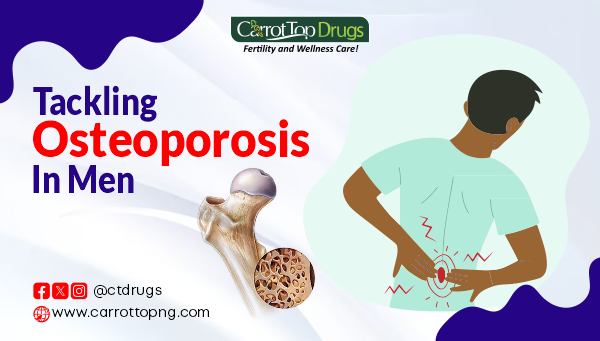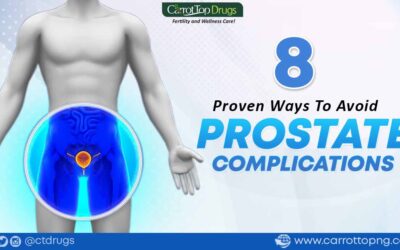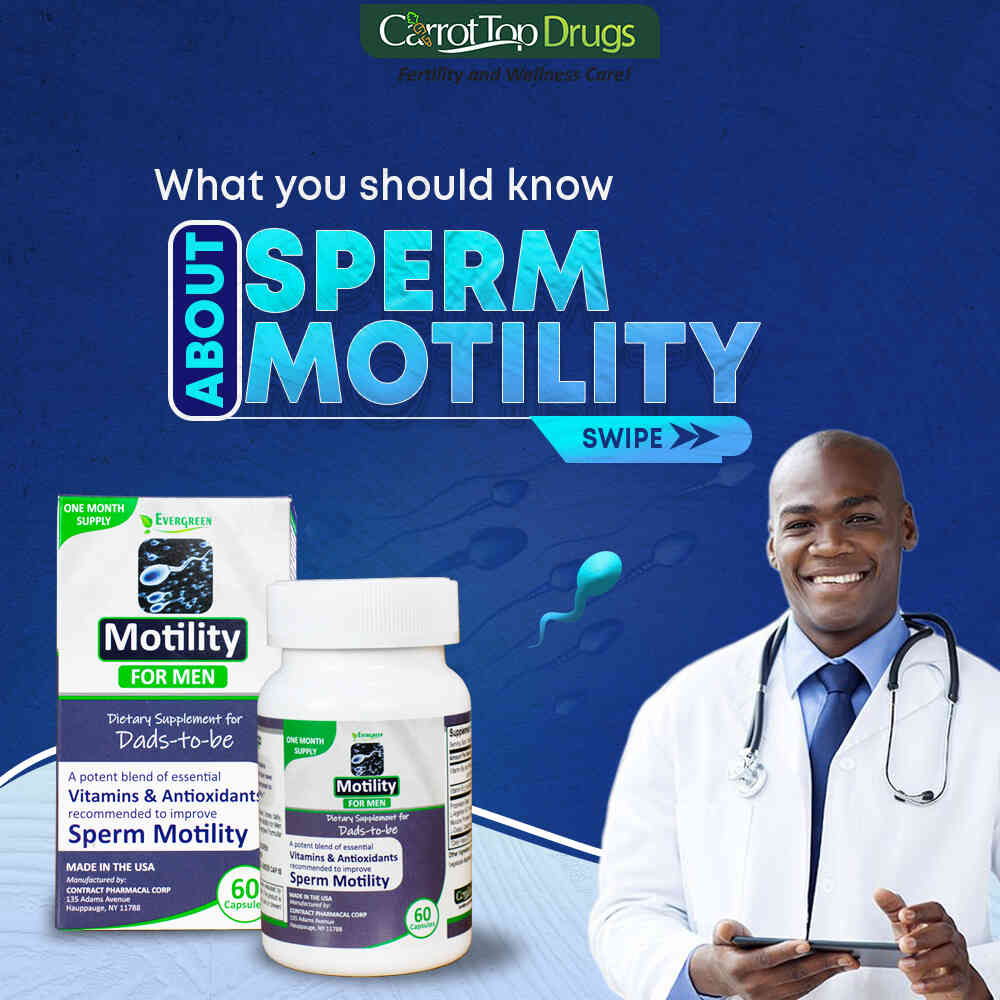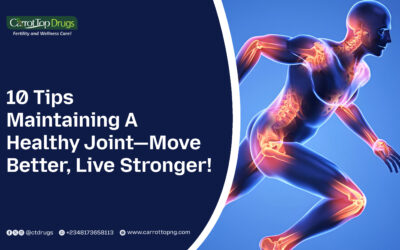Introduction
Osteoporosis, a condition characterized by weakened bones, poses a significant health threat to men. In this article, we will look into the importance of tackling osteoporosis in men. Understanding the risk factors and strategies for prevention is crucial for maintaining bone health and overall well-being. Let’s explore how men can effectively address this condition and lead healthier lives.
Definition
According to the World Health Organization, osteoporosis is a progressive disease that weakens bones, increasing the risk of fractures. This makes bones more likely to break or fracture, even from minor falls or bumps. Essentially, osteoporosis makes bones less dense and more fragile, which can lead to serious health problems if not properly managed.
Incidence of Osteoporosis In Men
The incidence of osteoporosis in men is often overlooked but significant. While it is more prevalent in women, it still affects a considerable number of men worldwide.
The prevalence of osteoporosis in men around the world was found to be 11.7%. It is said by the International Osteoporosis Foundation that the chronic disease affects one in five men over the age of 50 years. Statistics from the International Osteoporosis Foundation revealed that approximately 1 in 5 men over the age of 50 will experience an osteoporotic fracture in their lifetime. According to a research by Guiseppe Rinonapoli et al, despite the lower overall incidence compared to women, the consequences of osteoporosis-related fractures tend to be more severe in men, leading to higher mortality rates. Recognizing the importance of tackling osteoporosis in men is vital for promoting bone health and preventing debilitating fractures.
Risk Factors Of Osteoporosis In Men
Age:
As men age, their bones naturally become less dense and weaker. This process, known as bone remodeling, occurs throughout life but accelerates as men get older. As a result, older men are more susceptible to developing osteoporosis.
Hormonal Imbalances:
Hormones play a crucial role in maintaining bone health. Reduced levels of testosterone, the primary male sex hormone, can contribute to bone loss and osteoporosis in men. Additionally, conditions such as hypogonadism (low testosterone production) can increase the risk of osteoporosis.
Lifestyle Factors:
Certain lifestyle choices can weaken bones and increase the risk of osteoporosis. For example, a diet lacking in calcium and vitamin D, essential nutrients for bone health, can lead to bone loss over time. Similarly, sedentary lifestyles with little physical activity can weaken bones and decrease bone density.
Medical Conditions:
Several medical conditions can predispose men to osteoporosis. Chronic diseases such as rheumatoid arthritis, inflammatory bowel disease, and certain cancers can affect bone health. Additionally, conditions that affect hormone levels or nutrient absorption, such as hyperthyroidism or celiac disease, can contribute to osteoporosis.
Medications:
Certain medications can have adverse effects on bone health and increase the risk of osteoporosis. For example, long-term use of corticosteroids, commonly prescribed for conditions like asthma or rheumatoid arthritis, can weaken bones and lead to osteoporosis. Other medications, such as some anti-seizure drugs and certain cancer treatments, may also contribute to bone loss.
Family History:
A family history of osteoporosis or fractures can increase the likelihood of developing the condition. Genetics play a significant role in determining bone density and structure, so individuals with a family history of osteoporosis may have a higher risk themselves.
Smoking and Alcohol Consumption:
Smoking and excessive alcohol consumption can negatively impact bone health and increase the risk of osteoporosis. It interferes with the body’s ability to absorb calcium, while heavy alcohol consumption can decrease bone density and weaken bones over time. Avoiding these habits can help protect against osteoporosis.
Signs and Symptoms of Osteoporosis in Men:
Bone Fractures:
Fractures, particularly in the spine, hips, and wrists, are a common sign of osteoporosis in men. These fractures may occur with minimal trauma or even during routine activities like bending or lifting.
Back Pain:
Chronic back pain, especially in the lower back, can be a symptom of vertebral fractures caused by osteoporosis. This pain may worsen with movement or prolonged periods of standing or sitting.
Loss of Height:
Osteoporosis-related vertebral fractures can lead to a gradual loss of height over time. Men may notice a reduction in their overall height or a stooped posture due to compression fractures in the spine.
Changes in Posture:
As vertebral fractures progress, individuals may develop a rounded or hunched posture, commonly referred to as kyphosis or Dowager’s hump. This change in posture can affect mobility and increase the risk of further fractures.
Decreased Grip Strength:
Weakening of the bones and muscles due to osteoporosis can result in a decline in grip strength. Men may notice difficulties with tasks that require gripping or lifting objects.
Brittle Nails:
Changes in nail texture and quality, such as increased brittleness or slow growth, can sometimes indicate underlying bone health issues, including osteoporosis. However, this symptom is less common and may vary among individuals.
Receding Gum Line:
Osteoporosis can affect the bones that support the teeth, leading to a receding gum line or loose teeth. Dental issues, such as tooth loss or gum disease, may occur as a result of decreased bone density.
Increased Risk of Falls:
Weakened bones and impaired balance associated with osteoporosis can elevate the risk of falls in men. Individuals may experience frequent stumbling or difficulty maintaining balance, increasing their susceptibility to fractures.
Diagnosing Osteoporosis in Men:
Bone Density Scan (DEXA):
A Dual-Energy X-ray Absorptiometry (DEXA) scan is the gold standard for diagnosing osteoporosis. This non-invasive imaging test measures bone mineral density (BMD) at various sites, such as the hip and spine. Results are compared to the average BMD of young adults to determine bone health.
Blood Tests:
Blood tests may be conducted to measure levels of certain markers associated with bone turnover, such as calcium, vitamin D, and markers of bone formation and resorption. Abnormal levels can indicate potential bone health issues and guide further evaluation.
X-rays:
X-rays may be used to detect fractures or changes in bone structure associated with osteoporosis. While not as sensitive as DEXA scans for diagnosing osteoporosis, X-rays can still provide valuable information about bone health and potential complications.
Quantitative Ultrasound (QUS):
Quantitative ultrasound is a portable and radiation-free method of assessing bone density, particularly at the heel or shinbone. While less commonly used than DEXA scans, QUS can be a useful screening tool, especially in settings where DEXA scans are not readily available.
FRAX Tool:
The Fracture Risk Assessment Tool (FRAX) is a calculator that estimates the 10-year probability of a major osteoporotic fracture or hip fracture based on clinical risk factors and BMD, if available. It helps healthcare providers assess an individual’s fracture risk and guide treatment decisions.
Clinical Evaluation:
A comprehensive clinical evaluation, including medical history, physical examination, and assessment of risk factors, is essential for diagnosing osteoporosis in men. Healthcare providers may inquire about symptoms, lifestyle habits, family history, and previous fractures to better understand an individual’s risk profile.
Specialized Tests:
In some cases, additional specialized tests may be recommended to assess bone health and identify underlying causes of osteoporosis. These tests may include bone turnover markers, genetic testing, or imaging studies such as computed tomography (CT) scans or magnetic resonance imaging (MRI).
Consultation with Specialists:
Depending on individual circumstances, consultation with specialists such as endocrinologists or rheumatologists may be warranted for further evaluation and management of osteoporosis in men. These healthcare professionals can offer specialized expertise and treatment options tailored to the individual’s needs.
Preventive Measures Against Osteoporosis in Men:
Dietary Calcium and Vitamin D:
Ensure adequate intake of calcium-rich foods like dairy products, leafy greens, and fortified foods, along with vitamin D sources like sunlight exposure and supplements to support bone health. Also in tackling osteoporosis in men, taking supplements like Evergreen Hale and Hearty Men 50+ especially for men above 50 years.
Regular Weight-Bearing Exercise:
Engage in weight-bearing exercises such as walking, jogging, dancing, or weightlifting to strengthen bones and improve bone density, reducing the risk of osteoporosis.
Quit Smoking and Limit Alcohol:
Quit smoking to minimize bone loss and improve bone health, while limiting alcohol consumption to moderate levels to prevent weakening of bones and decrease fracture risk.
Treatment Modalities of Osteoporosis in Men:
Medications for Bone Health:
Various medications are available to help strengthen bones and reduce the risk of fractures in men with osteoporosis. These may include bisphosphonates, which inhibit bone resorption and help maintain bone density, or other medications such as denosumab, teriparatide, or romosozumab. These medications are often prescribed as part of a comprehensive treatment plan aimed at tackling osteoporosis in men.
Hormone Therapy:
Hormone therapy, particularly testosterone replacement therapy (TRT), may be recommended for men with low testosterone levels contributing to osteoporosis. R M Francis in a research article stated that Testosterone replacement therapy improves bone density in men with hypogonadal osteoporosis, particularly if the epiphyses are still open. By restoring hormonal balance, TRT can help improve bone density and reduce fracture risk, especially in men with hypogonadism or other hormonal imbalances. This is another way used in tackling osteoporosis in men.
Lifestyle Modifications:
Tackling osteoporosis in men often involves implementing lifestyle changes to support bone health. This includes adopting a balanced diet rich in calcium and vitamin D, engaging in regular weight-bearing exercises, quitting smoking, moderating alcohol intake, and taking precautions to prevent falls and fractures.
Calcium and Vitamin D Supplements:
Supplemental calcium and vitamin D may be prescribed to ensure adequate nutrient intake for bone health, especially in men who are unable to meet their dietary requirements through food alone. These supplements can help support bone strength and density, reducing the risk of osteoporosis-related fractures. Our Evergreen Bone Support and Evergreen Joint Care supplements both have calcium and Vitamin D and can help in tackling osteoporosis in men.
Physical Therapy:
Physical therapy may be recommended to improve strength, flexibility, and balance, reducing the risk of falls and fractures in men with osteoporosis. Therapists can develop tailored exercise programs to address individual needs and improve overall functional capacity, tackling osteoporosis in men from a rehabilitative perspective.
Surgical Interventions:
In severe cases of osteoporosis where fractures are frequent or debilitating, surgical interventions may be necessary to stabilize bones and alleviate symptoms. Procedures such as vertebroplasty or kyphoplasty may be performed to treat vertebral compression fractures and restore spinal alignment, improving the quality of life for men with advanced osteoporosis.
Regular Monitoring and Follow-Up:
Monitoring bone density through periodic DEXA scans and evaluating treatment efficacy is essential for managing osteoporosis in men. Healthcare providers may adjust treatment plans as needed based on changes in bone health and individual response to therapy, ensuring optimal outcomes in tackling osteoporosis in men.
Conclusion
In conclusion, osteoporosis poses a significant health threat to men, yet it is often overlooked or underestimated. By recognizing the importance of tackling osteoporosis in men and implementing preventive measures, early detection strategies, and appropriate treatment modalities, individuals can effectively manage this condition and maintain bone health.
FAQs
Q. Is osteoporosis only a concern for women?
- No, osteoporosis can affect men as well, although it is less common. Men are also at risk of developing osteoporosis, especially as they age or if they have certain risk factors.
Q. Can osteoporosis be prevented?
- While osteoporosis cannot always be completely prevented, adopting a healthy lifestyle that includes proper nutrition, regular exercise, and avoiding harmful habits like smoking and excessive alcohol consumption can help reduce the risk.
Q. Are fractures the only complication of osteoporosis?
- While fractures are a significant concern, osteoporosis can also lead to chronic pain, decreased mobility, and a reduced quality of life. It can also increase the risk of other health complications.
Q. How is osteoporosis diagnosed in men?
- Osteoporosis in men is diagnosed through a combination of bone density scans, blood tests, X-rays, and clinical evaluations. These tests help assess bone health and determine the presence of osteoporosis.
Q. What are the treatment options for osteoporosis in men?
- Treatment options for osteoporosis in men may include medications to strengthen bones, hormone therapy, lifestyle modifications, calcium and vitamin D supplements, physical therapy, and, in severe cases, surgical interventions. Treatment plans are tailored to individual needs and risk factors.

















